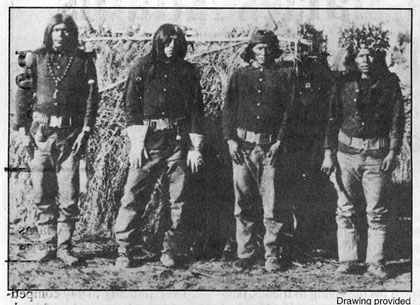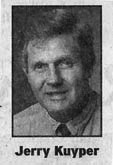
E. A. Burbank of Harvard sketched and painted many Sioux and
Apache Indian chiefs, including Geronimo.

E. A. Burbank of Harvard sketched and painted many Sioux and
Apache Indian chiefs, including Geronimo.

Young Harvard artist meets Chief Geronimo
Jerry Kuyper
Date Unknown
© Northwest Herald, used with permission
HARVARD - When the subject comes to cowboys and Indians, the cinema versions come readily to mind.
Gary Cooper tosses a sheriff's badge into a dusty street.
Roy Rogers outwits the bank robbers and waves to thankful townspeople as Trigger trots into an Arizona sunset.
Gene Autry captures the bad guys and rides away on Champion, strumming a guitar while singing "Back in the Saddle Again."
John Wayne exhibits manly grit in, well, "True Grit."
And then there are the legends that actually lived in the Old West and, to an extent, were captured on Hollywood film.
Wyatt Earp is settling old scores at Tombstone's OK Corral.
Wild Bill Hickok picks up his dead man's hand (pairs of aces and eights) at a poker game in Deadwood, S.D. Jack McCall lurks in the background.
Sioux warriors of Sitting Bull and Crazy Horse are slaughtering the command of Gen. George Armstrong Custer in the foothills of southern Montana.
Geronimo burns, pillages and massacres white settlers or drifters with equal fervor. From the 1840s to the 1880s, this Chiricahua Apache chief spread fear among any fool intrepid enough to venture without military escort into the desert country of southern Arizona.
Is it not conceivable that E. A. Burbank gulped twice before taking the old desert warrior on, all by himself? This is what he did in the latter years of the 19th century.
Born in 1858 in Illinois, a state where the last Indian to roam the northern Illinois prairie was exiled to Iowa after the 1832 Black Hawk War, Burbank was not acquainted with hostile Native Americans.
He was familiar, though, with pen, paint, brush, paper and canvas.
Armed with his artistic armaments, the Harvard native set out at the behest of his uncle to meet and greet and paint famous Indians of the mountains, deserts and plains.
Some of the famous chiefs still were alive in the late 1890s when Burbank began his anthropological sojourn. One of them was Geronimo.
"This wily, daring old Apache had won for himself a fearsome reputation throughout the country when my uncle, Edward E. Ayer, (first) president of the Field Museum in Chicago, commissioned me to go to Fort Sill (Okla.) in the old Indian territory and paint
Geronimo's portrait," Burbank wrote in a 1944 book of remembrances.
"Having heard of Geronimo only through the screaming newspaper headlines which exploited his daring raids and cruel massacres, I Was prepared to meet a thoroughly bloodthirsty savage. I gave thanks that I did not have to encounter this crafty Apache at large, but instead could sketch him behind prison bars.
"Imagine my great surprise upon arriving at Fort Sill to find that Geronimo was not in prison at all but was allowed his freedom. He lived in a house the government had built for him, a one-story affair built around a patio," Burbank said.
The artist from Harvard, who had trained for his vocation at home and abroad, hesitated before rapping a knuckle on Geronimo's front door. A little boy approached and told Burbank that the 69 year old chief was out "hunting horses."
I sat down upon the steps and waited. Presently an elderly Indian came riding up on a horse and dismounted. He was short but well-built and muscular. His keen, shrewd face was deeply furrowed with strong lines. His small black eyes were watery but in them there burned a fierce light. It was a wonderful study, that face so gnarled and furrowed. I studied it as he came over to me."
The artist introduced himself to the old chieftain. Geronimo asked Burbank why he had come to Fort Sill. Burbank said he was there to see the Indians and the country. He could get down to the business of painting the chief after the polite period ended.
"I offered him a cigarette and lighted one myself," Burbank said.
"We sat there and smoked for a while without saying anything. All this time Geronimo was peering at my face. He knew I had some further object in being there. Finally he asked me to tell him about Chicago," Burbank said.
Burbank related what he knew, reluctant to ask the chief's permission to paint him. Finally the artist got his courage and told the chief, "I am an artist. I also came to Fort Sill to paint a picture of Big Chief Geronimo."
The big chief liked what he heard and invited Burbank to return to the one-story home at the fort the following day.
"Next morning I was on hand bright and early at Geronimo's house to start work on his portrait. I found him ready and eager to pose. But just after I had outlined the sketch in pencil, he held up his hand," Burbank said.
Geronimo, as it turned out, had a head for business, as well as guerrilla warfare tactics. He wanted money for being Burbank's model. They settled on $5 for two pictures and the endeavor began. Geronimo sat on a bed and Burbank on a box. There were no chairs in the house.
"I never had a finer sitter than Geronimo, although sometimes he became very nervous while posing," Burbank said.
"As we worked day after day, my idea of Geronimo, the Apache, changed. I became so attracted to the old Indian that eventually I painted seven portraits of him," Burbank said.
Known paintings of Burbank are in the permanent collection of the Butler Institute of American Art at Youngstown, Ohio. About.200 sketches are in Chicago's Newberry Library collection.
Before he died in 1909, Geronimo became a national celebrity, even appearing at the St. Louis World's Far and in Theodore Roosevelt's 1901 inaugural procession. Burbank never acquired much fame, dying in poverty and anonymity in 1949. His ashes are in the Mount Auburn Cemetery mausoleum in Harvard.